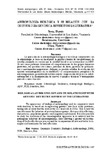| dc.rights.license | http://creativecommons.org/licenses/by-nc-sa/3.0/ve/ | es_VE |
| dc.contributor.author | Sosa Marquina, Dario Ernesto | |
| dc.contributor.author | Solórzano N., Eduvigis | |
| dc.contributor.author | Díaz, Nancy | |
| dc.date.accessioned | 2019-12-03T16:04:12Z | |
| dc.date.available | 2019-12-03T16:04:12Z | |
| dc.date.issued | 2019-12-03 | |
| dc.identifier.issn | 2542-3304 | |
| dc.identifier.uri | http://www.saber.ula.ve/handle/123456789/46358 | |
| dc.description.abstract | La aparición de la antropología biológica y su trabajo cooperativo con
la odontología se basa en incorporar la genética dentro de sus problemas de
estudio, tomando en cuenta que la cavidad bucal es un terreno rico en ADN.
Es así como podemos determinar el comportamiento de los grupos humanos
pretéritos, sus posibles afecciones, patrones de dieta, genética de poblaciones y movimientos migratorios.
Además, es posible estudiar la evolución del
aparato estomatognático en su totalidad y el comportamiento patogénico de
microorganismos, permitiendo así una mayor comprensión del proceso saludenfermedad y
la incorporación de nuevas y mejores técnicas y tratamientos para afecciones bucales. | es_VE |
| dc.language.iso | es | es_VE |
| dc.publisher | SaberULA | es_VE |
| dc.rights | info:eu-repo/semantics/openAccess | es_VE |
| dc.subject | Odontología Genómica | es_VE |
| dc.subject | Antropología Biológica | es_VE |
| dc.subject | ADN | es_VE |
| dc.subject | PCR | es_VE |
| dc.subject | Genética | es_VE |
| dc.subject | Gen | es_VE |
| dc.title | Antropología Biológica y su relación con la Odontología Genómica. Revisión de la literatura | es_VE |
| dc.title.alternative | Biological anthropology and its relationship with genomic dentistry. Review of the literature | es_VE |
| dc.type | info:eu-repo/semantics/article | es_VE |
| dcterms.dateAccepted | 03-07-2019 | |
| dcterms.dateSubmitted | 17-01-2019 | |
| dc.description.abstract1 | The appearence of biological anthropology and its cooperative work
with dentistry is based on incorporating genetics into their study problems,
taking into account that the oral cavity is a land rich in DNA. This is how we
can determine the behavior of preterm human groups, their possible affections,
diet patterns, population genetics and migratory movements. It is also possible
to study the evolution of the stomatognathic apparatus in its entirety and the
pathogenic behavior of microorganisms, thus allowing a greater un-derstan- ding of the health-disease
process and the incorporation of new and better techniques and treatments for oral affections. | es_VE |
| dc.description.colacion | 447-470 | es_VE |
| dc.description.email | dario.sosa@gmail.com | es_VE |
| dc.description.email | duvisolorzano@gmail.com | es_VE |
| dc.description.email | jabibe75@gmail.com | es_VE |
| dc.description.frecuencia | Semestral | |
| dc.description.paginaweb | www.saber.ula.ve/boletin_antropologico | |
| dc.identifier.edepositolegal | ppi201403ME788 | |
| dc.publisher.pais | Venezuela | es_VE |
| dc.subject.institucion | Universidad de Los Andes | es_VE |
| dc.subject.keywords | Genomics Dentistry | es_VE |
| dc.subject.keywords | Biological Anthropology | es_VE |
| dc.subject.keywords | DNA | es_VE |
| dc.subject.keywords | PCR | es_VE |
| dc.subject.keywords | Genetics | es_VE |
| dc.subject.keywords | Gen | es_VE |
| dc.subject.seccion | Boletín Antropológico: Artículos | es_VE |
| dc.subject.tipo | Artículos | es_VE |
| dc.type.media | Texto | es_VE |


